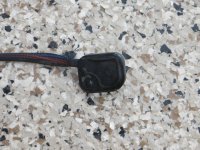DanF
Seasoned Member
After having 2 sensors replaced at the dealer to get my top working again I decided to take one apart. The following pictures are of the top sensor, this little thing cause major top and trunk failures. How it works explained here: Potentiometer - Wikipedia, the free encyclopedia

Part Number

There are 3 Sensors

Small Plastic Shaft the drives the internals, half round, half flat.

The inside

This where it happens, small plastic shaft rotates the internal electrical positioner sending a signal to the computer tell it where the top is.
As you can see all the components are small and delicate.
Part Number
There are 3 Sensors
Small Plastic Shaft the drives the internals, half round, half flat.
The inside
This where it happens, small plastic shaft rotates the internal electrical positioner sending a signal to the computer tell it where the top is.
As you can see all the components are small and delicate.






